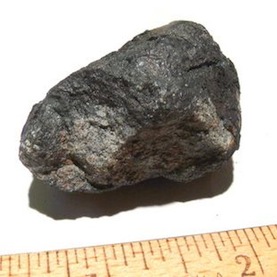
October 24 Update: It now appears that the rock found in Lisa Webber’s backyard is not, in fact, a meteorite. “I sincerely thought it was, based on what appeared to me was remnant fusion crust,” Peter Jenniskens wrote in a statement on the CAMS site. “On closer inspection, that crust was a product of weathering of a natural rock, not from the heat of entry.” The rock was magnetic and had a density similar to that expected for meteorites. Jenniskens and Webber spent some time searching her yard for another meteorite candidate without success. Scientists are hoping the meteorite associated with the October 17 fireball will turn up, allowing for further study.
On October 17, an early Orionid meteor surprised residents of northern California when it streaked a fireball across the sky emitting a sonic boom. But it wasn’t until October 20 that Novato resident Lisa Webber found the meteorite in her backyard.
Webber heard a bump on her roof the evening of the 17th, but didn’t connect it with the fireball until she read about it the newspaper the next dead. She quickly spotted the 63 gram stone and called Peter Jenniskens of the Cameras for Allsky Meteor Surveillance (CAMS) project. “I wasn’t sure at first,” said Jenniskens in a statement on the CAMS website. “The meteorite looks very unusual, because much of the fusion crust had come off.” But Jenniskens ultimately confirmed the origin of the rock which appears to be a breccia.
The meteorite will be used to trace its origin in the asteroid belt. Although meteorites have been known to damage property in the past, only one person has even been struck by a falling meteorite, and that without injury. Often times meteors such as what is being called the Novato meteorite, pending approval by the Meteorite Nomenclature Committee, are too small to be easily tracked before they plummet through the atmosphere. Nearly 40 tons of meteorites reach Earth every day, but most of them are no more than dust by the time they reach the ground.
Below, a recording of the Oct 17th fireball:

















































































































![A trajectory analysis that used a computational fluid dynamics approach to determine the likely position and velocity histories of the foam (Credits: NASA Ref [1] p61).](http://www.spacesafetymagazine.com/wp-content/uploads/2014/05/fluid-dynamics-trajectory-analysis-50x50.jpg)



Leave a Reply